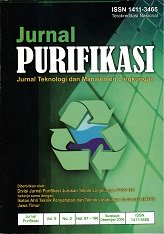PENGARUH KANDUNGAN SULFAT TERHADAP PARAMETER KINETIKA MIKROBA DALAM PEMBUATAN BIOGAS DENGAN PENAMBAHAN SULFAT REDUCING BACTERIA (SRB)
Main Article Content
Abstract
The global energy crisis that has occurred recently made engineers and policy makers to realize that dependency on natural oil should be reduced. In order to respond to this situation, development of technology for alternative non-oil fuel production, which is environmental friendly, should be generated. Biogas is an alternative energy, which has been widely researched by many scientists. The purpose of this research is to optimize biogas production from industrial wastewater treatment sludge of PT SIER by reducing sulphate content using Sulphate Reducing Bacteria (SRB) and to determine the kinetics parameters for reactor design. The SRB which was used in this research was Desulfovibrio desulfuricans. The SRB reduced the formation of hydrogen sulfide (H2S) from sulphate. From former research, it was obtained that the addition of 0.1% SRB resulted in high CH4 and low H2S contents. In this research batch digesters with COD/sulphate ratios of 2:1 and 2.5:1 and addition of 0.1% SRB were used for 15 days. The results showed that digester with COD/SO42- ratio of 2:1 showed better performance than that with COD/SO42- ratio of 2.5:1. The gas compositions in the reactor with COD/SO42- ratio of 2:1 were: CH4 = 78.4 %, H2S = 0.16%, and CO2 = 15.90% . The measured heat value in this reactor was 11,980 Kcal/kg; and the percentage of H2S reduction was 94.30%. The gas compositions in the reactor with COD/SO42- ratio 2.5:1 were CH4 = 76.82%, H2S = 0.22%, CO2 = 16.42%. The heat value in this reactor was 11,820 Kcal/kg, and H2S reduction was 92.10%. The sulphate reduction in the reactor with COD/SO42- ratio of 2:1 is 89.2%, with kinetics velocity (µm) = 0,008 L/day, Km = 5907.943 mg/L, and Yield = 5.668. Additionally, in reactor with COD/SO42- ratio 2.5:1, the sulphate reduction was 86.6% with kinetics velocity (µm) = 0.002 L/day, Km = 6179.315 mg/L, and Yield = 2.626.
Downloads
Article Details
Submission of a manuscript to Jurnal Purifikasi means that the work has never been published in another journal and is not under consideration for publication elsewhere. The author hereby agrees to submit the copyright of the manuscript and its contents to Jurnal Purifikasi, if accepted for publication. Accepted manuscripts will be published in printed form where the ISSN is bound in printed form, not in online form (pdf). Authors are not allowed to publish their work in other forms (journals) without permission from the Jurnal Purifikasi manager.
By submitting a manuscript, the author is deemed to know all the rights and obligations attached to each manuscript.








